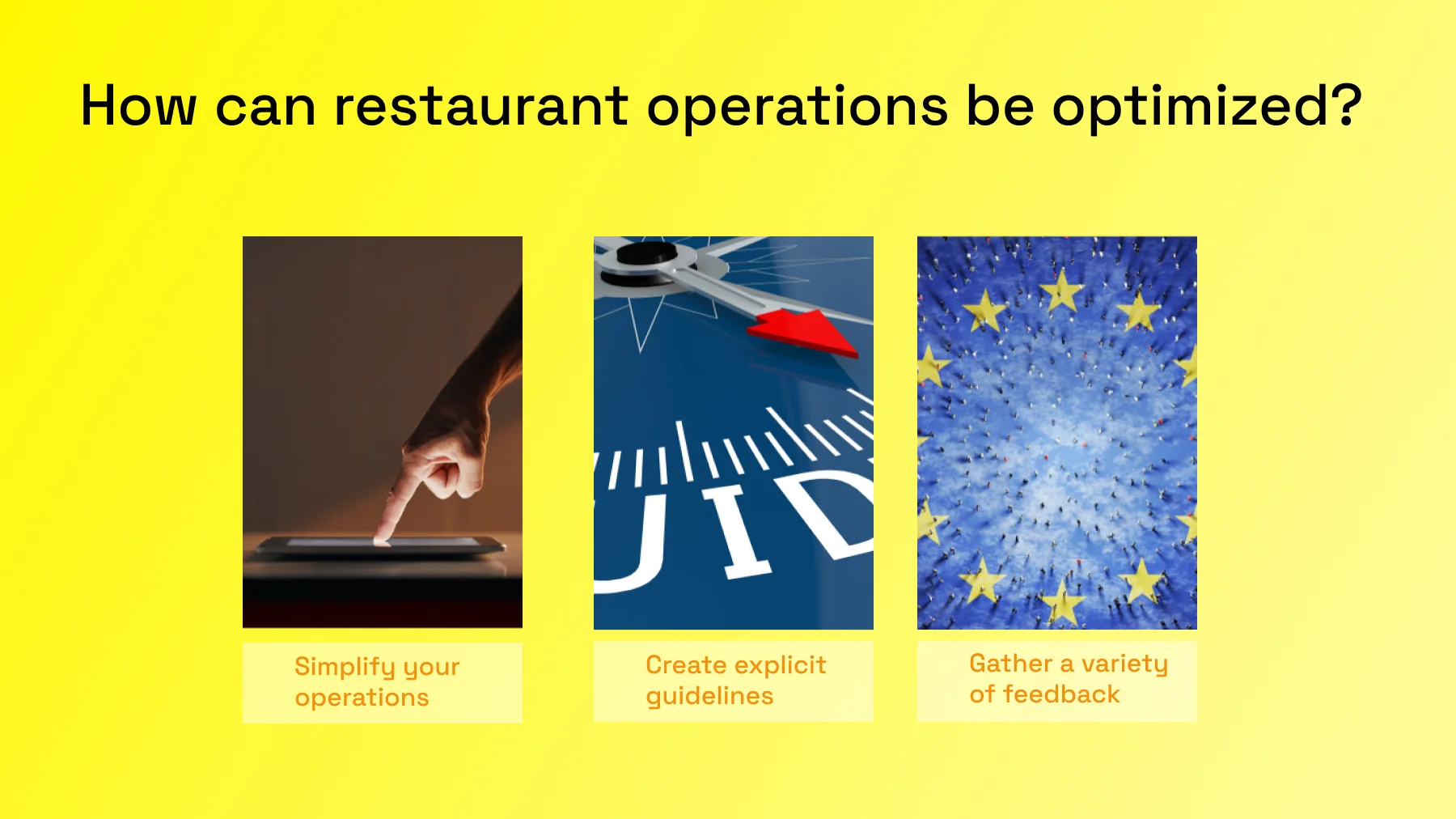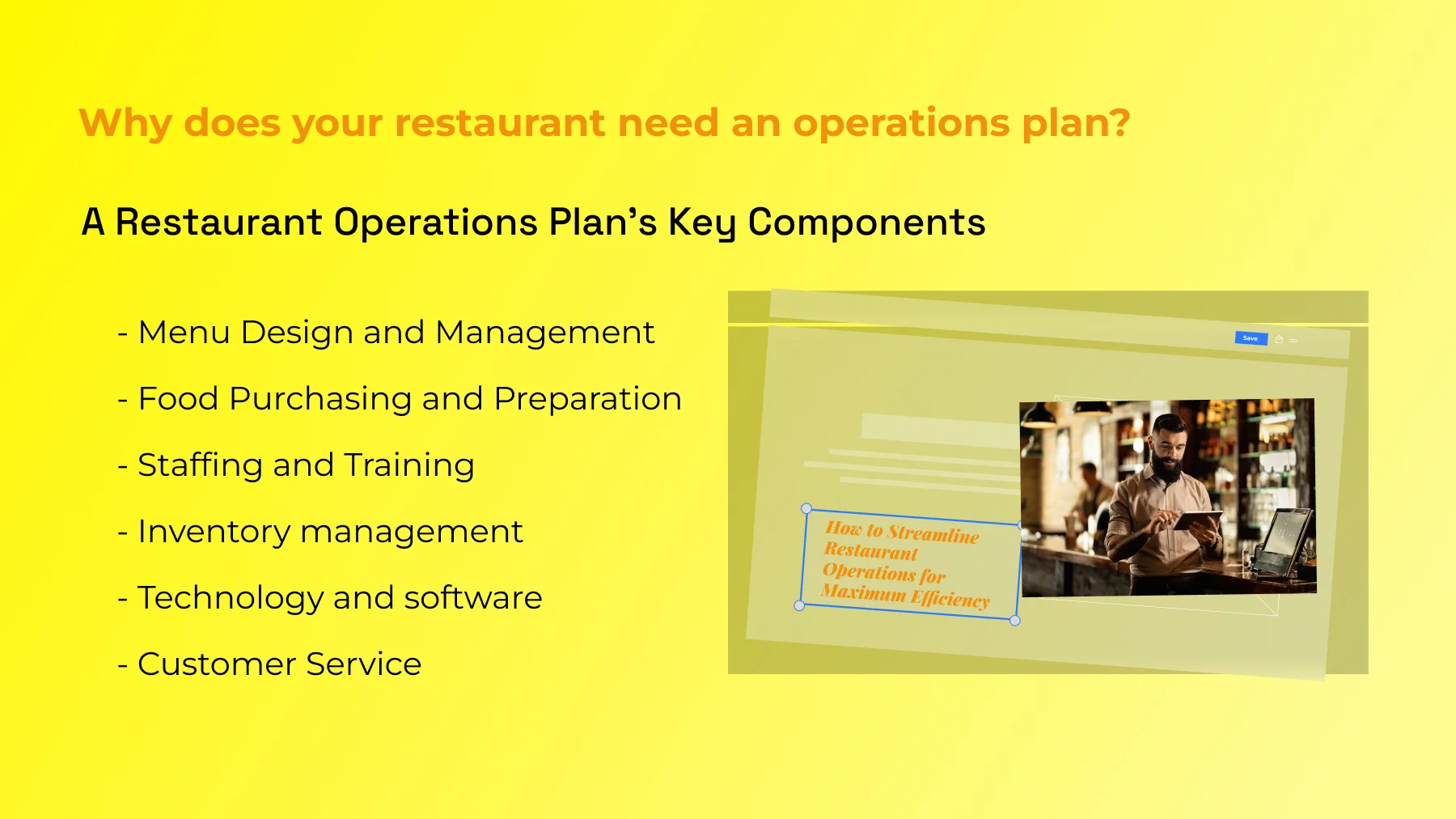How to Streamline Restaurant Operations for Maximum Efficiency
Restaurant operations include all aspects of a restaurant's everyday operations. Staff members undertake certain tasks that enable the restaurant to run and meet the demands of its customers, just like businesses in other industries. These processes have distinct roles, which may sometimes overlap. For example, service is one component of restaurant operations, and one of its tasks is to provide food to customers. Another component is preparation, which includes the creation of the meals served. To ensure a restaurant's success, the management or owner oversees all of these components.

Why Does Your Restaurant Need an Operations Plan?
Many restaurants close their doors permanently in less than a year. It's primarily because they didn't have an actionable operations plan for running an eatery.
If you think operations are insignificant, think again! Here are a few of the main reasons why you need an operations strategy for your restaurant.
The cost of running a restaurant is high. Clearly defined operations help reduce costs and food waste while also indicating potential methods to increase profits.
When you establish standards for everything, it becomes easier to provide consistent services. An operations plan aids in clearly defining the standards for different parts of an eatery business.
Emergencies are destined to occur. An operations plan assists you in planning and preparing for various scenarios, making the firm sound and secure.
Isn't it true that communication is essential? Operations set a distinct tone for individual responsibility and accountability. This will fix any communication concerns that lead to dissatisfaction among workers.
A Restaurant Operations Plan's Key Components
Are you starting to write the operations section of your business plan? Don't forget to include these essential elements to make your business plan relevant and useful.
1. Menu Design and Management
Including a sample menu in your new restaurant's business plan will help investors comprehend your product options.
Furthermore, what you intend to serve will have a direct and significant impact on the other components of your restaurant, including its target market, layout, and design.
Restaurants have razor-thin profit margins. As a result, it is important to discover menu items that are both profitable and popular.
Focus on a limited menu at first to keep food prices under control. Include foods that can be made with readily available, locally sourced ingredients.
Create a low-cost menu design. Implement recipe cost cards to figure out the actual cost of each menu item. Also, be certain that the prime costs of menu items do not exceed 66% of what you intend to charge.
2. Food Purchasing and Preparation
The food purchase and preparation process should be well defined in the operational plans of a restaurant.
Find a reliable source of raw materials for your restaurant. Inventory expenses will devastate your budget if they are not planned for and accounted for.
In your dishes, strike a balance between fresh and long-lasting ingredients. Find ways to reuse ingredients for multiple recipes to save money.
Create recipe cost cards for each item on your menu for consistency in preparation.
Ensure that the food preparation process guarantees quality. This will keep your target market loyal to your restaurant.
3. Staffing and Training
Employees play a vital role in bringing your restaurant's vision.
However, labor costs account for most operational expenses monthly. Identifying the precise staffing needs will allow you to make smart hiring decisions.
Mention your full-time and part-time employee hiring plans in the operational section of your restaurant business plan. Mention the salaries as well to offer possible investors an idea of the monthly payroll expenses.
Highlight your restaurant's employee training practices as well. Outline a detailed training program for your restaurant's front- and back-of-house staff.
Employees should be trained in taking orders, handling special requests, settling customer complaints, serving protocols, and so on.
4. Inventory management
The fundamental foundations of running a successful restaurant are efficient inventory and supply chain management.
Conduct competitive market research to determine your stock management strategy. A restaurant business plan's operations section must include the following details:
- Inventory restocking frequency
- Stock management techniques
- Inventory storage costs
- Suppliers and providers who will carry out the orders
- Methods of inventory tracking
- Plan for supply chain interruption
This section of a restaurant business plan significantly reduces the potential costs. Furthermore, effective inventory management will inspire potential investors to invest in your restaurant.
5. Technology and software
The operations section of your restaurant business plan has to offer a quick summary of the technological devices and tools that you will use in your restaurant.
Technology is critical to the restaurant's success. According to a market study, 91% of restaurant owners in the United States believe restaurant technologies are vital to their business.
Investigate your direct and indirect competitors' restaurant businesses to find out the technology they use.
Describe reservation tools, inventory management systems, payment systems, marketing tools, and other types of technology that will help you streamline your operations.
6. Customer Service
We are all aware that providing excellent customer service is essential for the success of a business.
The question is, how do you intend to offer continuous quality services to please customers?
Consider what factors can contribute to consumer satisfaction and shape your strategies accordingly.
Try answering questions like:
- How can you efficiently move consumers in the queue of operations without hushing them?
- How will you ensure consistency in food quality?
- How will the restaurant's management handle customer complaints?
- How do you want to attract your target market?
- Do you have up-to-date technology for digital and contactless payment?
- What will be the average serving time?
- What is your marketing strategy for keeping customers happy and loyal?
Your customers will decide the fate of your restaurant. All strategies and plans must strive to help you deliver a satisfying customer experience.
How Can Restaurant Operations Be Optimized?

You can utilize the following strategies to help you maximize your restaurant operations:
1) Simplify your operations
Identifying strategies to streamline various aspects of restaurant operations helps maximize their efficiency. The menu and staffing are two essential areas to simplify; both of which can offer several benefits. Restaurants can cut costs by limiting their menu items and the number of staff members by only focusing on what's necessary. Fewer menu options also help to reduce food waste, make the prep process more efficient, and boost inventory space. Spend time examining the demand for various items and consider eliminating the less popular choices.
Analyze your customer's needs to establish the essential restaurant roles you must fill and maintain. For example, you may measure demand at different times of day to decide how many waiters you need on staff to provide timely service. You can also search for other operational areas to simplify and improve, such as adopting inventory software to help automate specific tasks. Simple job automation can help free up your staff's time, allowing them to focus on more pressing restaurant responsibilities.
2) Create explicit guidelines
Establishing clear, standardized guidelines for each component of restaurant operations will help ensure success. The manager or owner of the restaurant might perform this responsibility or allow it to other leaders for their specific area of operations. For example, the chef may create guidelines for the staff to follow when making or storing food, whereas the restaurant manager may develop service standards for waitstaff. Transparent, consistent guidelines make it easier for staff members to comprehend and meet the restaurant's expectations.
Leaders can implement guidelines in a variety of ways, including manuals and checklists. For example, the management could create a cleanup checklist for employees to complete at the end of each day. This simple technique ensures that all cleaning tasks are completed under restaurant and industry standards. When drafting guidelines, solicit feedback from the staff members who will be accountable for following them. They may offer new perspectives to help you maintain realistic goals and efficient operations.
3) Gather a variety of feedback
Gathering feedback is an efficient way of measuring the effectiveness of strategic restaurant decisions. You can ask members of each operational department about their typical responsibilities and whether the present standards and procedures assist them in succeeding. You can also solicit ideas for potential improvements, such as introducing software that helps with task automation or changing schedules.
Consider getting feedback from your customers in addition to internal feedback. These people can give you a variety of opinions on your front-of-house operations, typically the service and cleanup sectors. This helpful feedback will assist you and your workers in identifying where the restaurant succeeds and where changes are still needed.
Following the feedback collected by these stakeholders, you can ensure your restaurant addresses both internal and external interests and expectations. As a result, you may encounter happier consumers and employees.
KEY TAKEAWAYS

